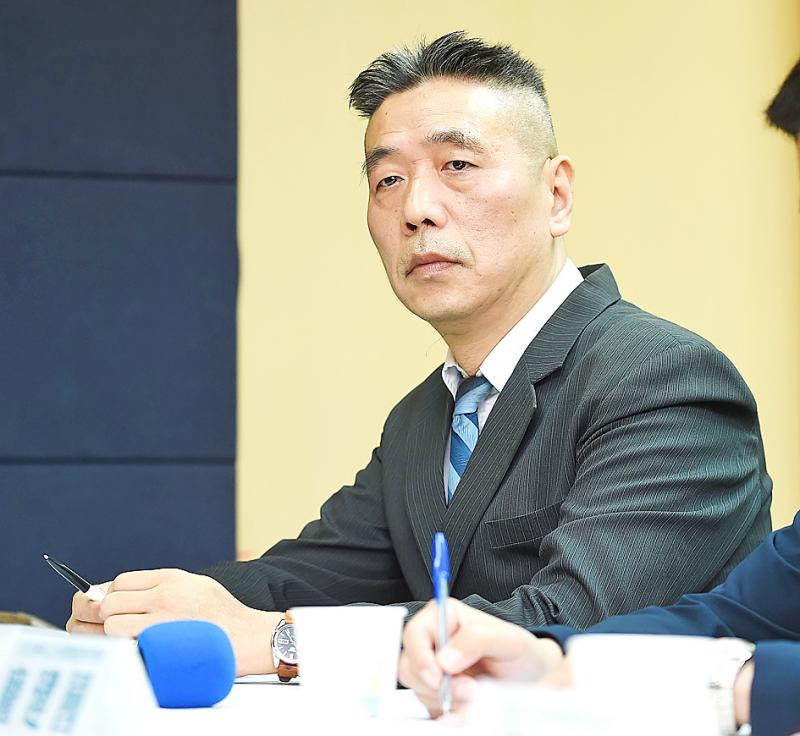The proposed sale of a coastal defense missile system that the US approved on Monday would complement Taiwan’s anti-ship missile system and boost its asymmetrical warfare capabilities, local military experts said yesterday.
Washington on Monday said that it approved a possible sale to Taipei of up to 100 Harpoon coastal defense systems and related equipment for about US$2.37 billion.
It was the second time in a week that Washington announced an arms sale to Taiwan and the ninth arms sale announced by US President Donald Trump since he took office in January 2017.

Photo: Chen Chih-chu, Taipei Times
Presidential Office spokesman Xavier Chang (張惇涵) said in a statement last week that the defensive weapons provided by the US help Taiwan “strengthen and modernize our national defense capabilities” and also increase “our asymmetric capabilities, making Taiwan more capable and confident of maintaining peace and stability in the Taiwan Strait and the region.”
The latest package includes 400 RGM-84L-4 Harpoon Block II surface-launched missiles, four RTM-84L-4 Harpoon Block II exercise missiles, 411 containers, 100 Harpoon launcher transport units, 25 radar trucks, spare and repair parts, support and test equipment, and logistics support services.
The missiles would be deployed on 25 vehicles.
Defense International Magazine senior editor Sung Yu-ning (宋玉寧) told the Central News Agency that Taiwan’s military already has three types of Harpoon missiles, AGM-84Ls, RGM-84Ls and UGA-84Ls, which are carried on fixed-wing aircraft, surface vessels and submarines respectively.
The Harpoon missiles approved for sale on Monday are for ground-based launchers in coastal areas, similar to Taiwan’s Hsiung Feng II anti-ship missile system produced by the National Chungshan Institute of Science and Technology, Sung said.
Compared with their predecessors, Harpoon Block II missiles have enhanced resistance to electronic countermeasures and improved targeting, making them more deadly to enemy vessels, he said.
Block IIs are capable of hitting targets offshore even when the waves are high, a perfect choice for Taiwan’s defense needs, he said, adding that they would compliment Hsiung Feng II missiles in a counterattack amid a potential invasion by China’s People’s Liberation Army (PLA) forces.
Meanwhile, Institute for National Defense and Security Research research fellow Su Tzu-yun (蘇紫雲) said that the latest arms packages, including a previous proposed sale of Land Attack Missile Expanded Response cruise missiles and Mobility Artillery Rocket Systems would quickly elevate the nation’s overall defensive capability with a limited defense budget.
The investment seeks to boost Taiwan’s asymmetric warfare capabilities to counter the growing military strength of the PLA and deter Chinese forces from invading, Su said.
Each of the 25 units carrying Block IIs would have a capacity of 16 missiles, equal to the firepower of two naval frigates and capable of eliminating invading PLA vessels, he said.
The arms packages would also help Taiwan forge closer links with allies, including the US and Japan, as part of Washington’s “island-hopping warfare,” which involves deploying missiles along Japan’s southwestern islands and elsewhere along the First Island Chain to counter China’s maritime expansion, Su said.

Taiwanese scientists have engineered plants that can capture about 50 percent more carbon dioxide and produce more than twice as many seeds as unmodified plants, a breakthrough they hope could one day help mitigate global warming and grow more food staples such as rice. If applied to major food crops, the new system could cut carbon emissions and raise yields “without additional equipment or labor costs,” Academia Sinica researcher and lead author the study Lu Kuan-jen (呂冠箴) said. Academia Sinica president James Liao (廖俊智) said that as humans emit 9.6 billion tonnes of carbon dioxide compared with the 220 billion tonnes absorbed

The Taipei Mass Rapid Transit (MRT) Wanda-Zhonghe Line is 81.7 percent complete, with public opening targeted for the end of 2027, New Taipei City Mayor Hou You-yi (侯友宜) said today. Surrounding roads are to be open to the public by the end of next year, Hou said during an inspection of construction progress. The 9.5km line, featuring nine underground stations and one depot, is expected to connect Chiang Kai-shek Memorial Hall Station to Chukuang Station in New Taipei City’s Jhonghe District (中和). All 18 tunnels for the line are complete, while the main structures of the stations and depot are mostly finished, he

Taipei is to implement widespread road closures around Taipei 101 on Friday to make way for large crowds during the Double Ten National Day celebration, the Taipei Department of Transportation said. A four-minute fireworks display is to be launched from the skyscraper, along with a performance by 500 drones flying in formation above the nearby Nanshan A21 site, starting at 10pm. Vehicle restrictions would occur in phases, they said. From 5pm to 9pm, inner lanes of Songshou Road between Taipei City Hall and Taipei 101 are to be closed, with only the outer lanes remaining open. Between 9pm and 9:40pm, the section is

China’s plan to deploy a new hypersonic ballistic missile at a Chinese People’s Liberation Army Rocket Force (PLARF) base near Taiwan likely targets US airbases and ships in the western Pacific, but it would also present new threats to Taiwan, defense experts said. The New York Times — citing a US Department of Defense report from last year on China’s military power — on Monday reported in an article titled “The missiles threatening Taiwan” that China has stockpiled 3,500 missiles, 1.5 times more than four years earlier. Although it is unclear how many of those missiles were targeting Taiwan, the newspaper reported